17 Types of Aquatic Flowers to Grow in Water
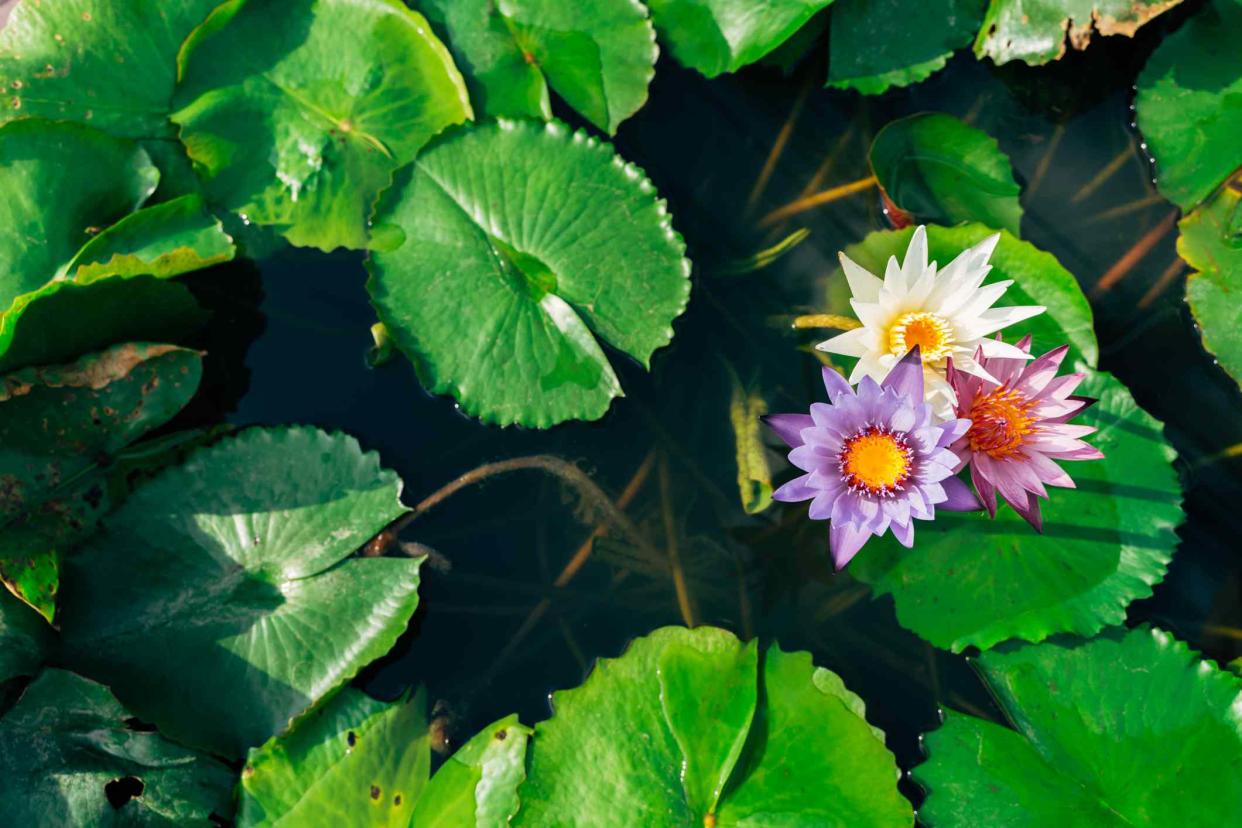
Carles Navarro Parcerisas / Getty Images
Reviewed by Kathleen Miller
Aquatic flowers turn water gardens and ponds into vibrant, flowering spaces. Aside from beautifying the area, plants add healthy foliage to the water. From small, dainty flowers to large, eye-catching specimens, there are water-loving plants for every pond size and flower preference. Learn more about 17 of the most popular aquatic flowers that can be grown in water.
16 Water Loving Plants for Wet Outdoor Areas
Water Lily
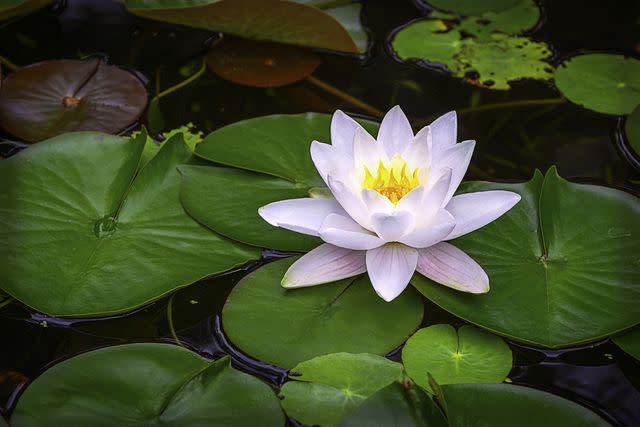
Joe Regan / Getty Images
Water lilies are among the most well-known aquatic flowers for good reason. They come in a wide range of varieties, some hardy and others tropical. Hardy varieties survive freezing temperatures while tropical varieties must be kept as annuals or grown in warm climates. Water lilies produce white, purple, pink, blue, yellow, orange, red, or peach blooms. depending on their variety. They also produce the iconic lily pad foliage. Not only do they beautify an area, but they clean the water and provide shelter for aquatic animals and fish.
Name: Water lily (Nymphaea spp.)
USDA Hardiness Zones: Hardy (3-11), Tropical (9-11)
Flower Color Varieties: Red, pink, purple, peach, blue, white, yellow, orange
Light: Full sun to partial shade
Soil Needs: Submerged, loamy, neutral to alkaline soil
Mature Size: 2-12 inches above water, 2-8 feet wide
Deer-Resistant: No
Lotus
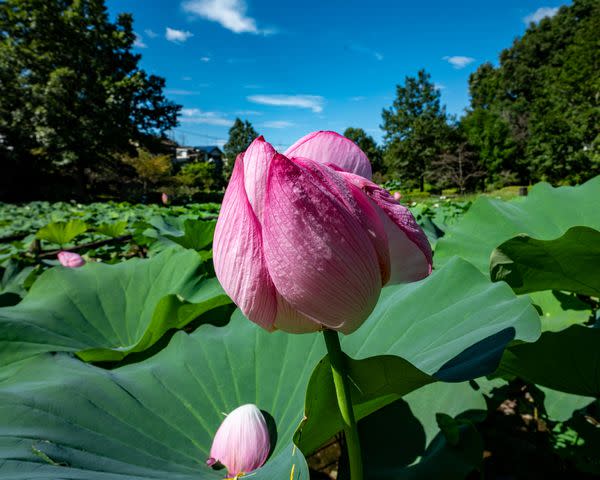
I love Photo and Apple. / Getty Images
Lotus flowers are often mistaken for water lilies because of their lily pad-like foliage and similar flower structure. Lotus flowers are pink or white, and rise tall above the water, unlike water lilies that often float on the surface. Lotus flowers reach up to a foot wide, and their circular foliage grows up to 2 feet wide. They are grown in both shallow water and water up to 8 feet deep. They are fast spreaders, so you may wish to keep them in large containers rather than plant them directly into the pond. Their spreading rhizomes can quickly take over a pond.
Name: Lotus (Nelumbo nucifera)
USDA Hardiness Zones: 4-9
Flower Color Varieties: Pink, white
Light: Full sun
Soil Needs: Submerged, loamy, neutral soil
Mature Size: 3-5 feet above water, 3-5 feet wide
Deer-Resistant: No
Water Poppy
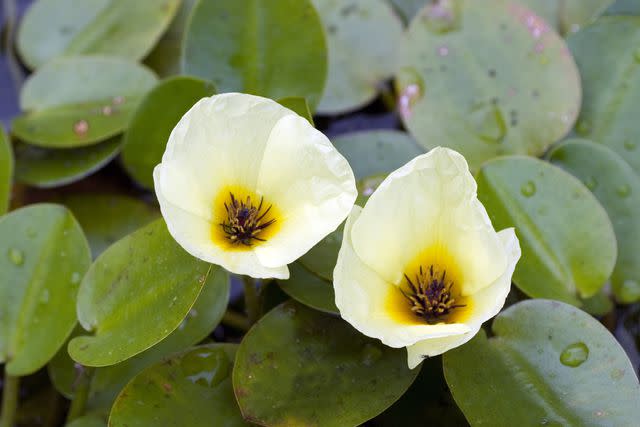
emer1940 / Getty Images
Water poppies produce shiny, circular to heart-shaped foliage and small, cheery yellow flowers. The individual foliage of this plant reaches 2 to 4 inches in diameter while the petite flowers are up to 2 inches in size. These plants either float on the surface of the water or rise above slightly. Although these dainty flowers only last one day, water poppies continue to bloom throughout the summer. Their small size makes them great for small ponds or pond edges. They prefer shallow water around 6 inches deep.
Name: Water poppy (Hydrocleys nymphoides)
USDA Hardiness Zones: 9-11
Flower Color Varieties: Yellow
Light: Full sun
Soil Needs: Shallowly submerged, loamy, acidic to neutral
Mature Size: 6-12 inches above water, 5 feet wide
Deer-Resistant: No
Water Hyacinth
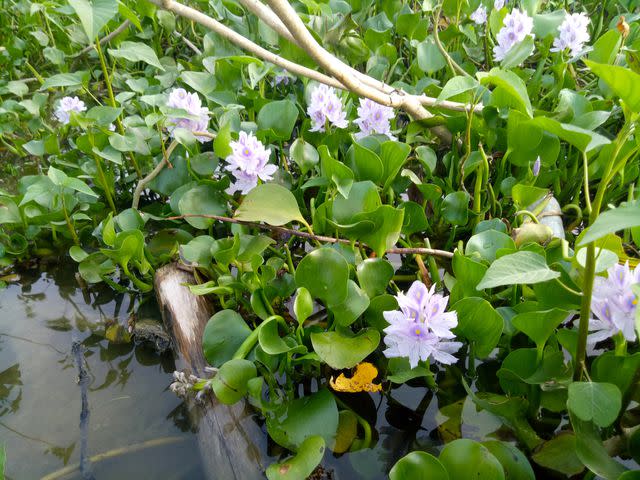
Yusuf Anton Mohamad / Getty Images
Water hyacinths are free-floating aquatic flowers that produce purple and yellow flower stalks that reach up to 12 inches tall. Their foliage is thick and round with long, bulbous stalks. Because they are free-floating, they do not need any soil to survive and are also used for indoor water gardens. These fast growers and spreaders quickly cover the entire surface of a pond, which may choke out sunlight and kill other aquatic plants. Therefore, it is important to keep water hyacinth under control. Growing them in floating baskets keeps them contained.
Name: Water hyacinth (Eichhornia crassipes)
USDA Hardiness Zones: 8-11
Flower Color Varieties: Purple and yellow
Light: Full sun
Soil Needs: None
Mature Size: 12 inches above water, 1-2 feet wide
Deer-Resistant: Yes
Water Iris
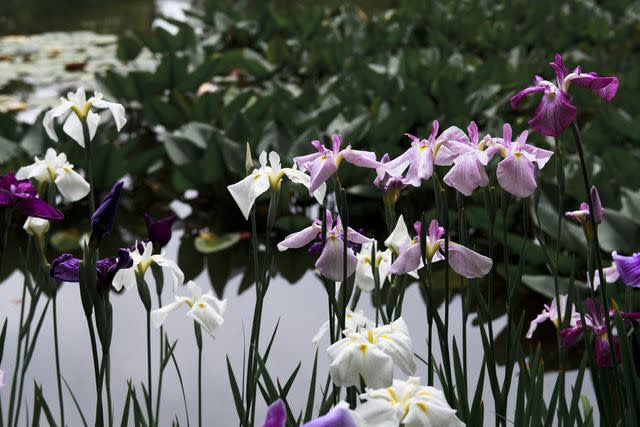
masahiro Makino / Getty Images
Irises may not be the first flower you think of when talking about aquatic flowers, but the water iris is a splendid addition to any pond edge. This type of iris sports the iconic three-petaled flower these plants are known for, along with long, grass-like foliage. They are best grown in shallow water up to 8 inches deep.
Name: Water iris (Iris laevigata)
USDA Hardiness Zones: 5-9
Flower Color Varieties: Purple, blue
Light: Full sun to partial shade
Soil Needs: Submerged, loamy, acidic soil
Mature Size: 2-3 feet above water, 1-2 feet wide
Deer-Resistant: Yes
Water Forget-Me-Nots
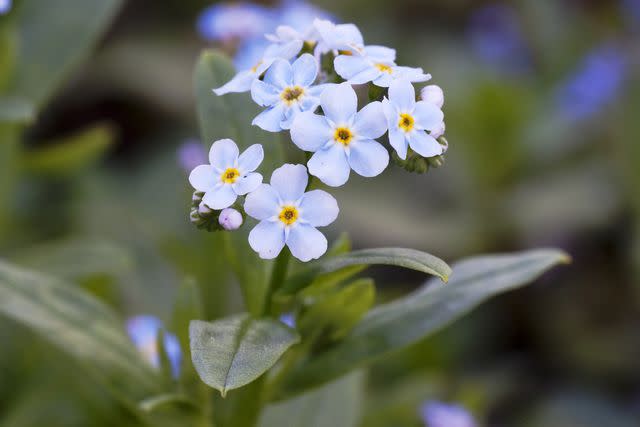
Naturfoto Honal / Getty Images
Another plant known for its land-dwelling varieties, water forget-me-nots are an ideal option for ponds and water gardens. These dainty blue and yellow flowers grow in shallow water up to 3 inches deep and thrive on pond edges. Simply plant them in shallow water or next to the water’s edge in wet soil. These plants offer a very low-maintenance landscaping option.
Name: Water forget-me-nots (Myosotis scorpioides)
USDA Hardiness Zones: 5-9
Flower Color Varieties: Blue and yellow
Light: Full sun to partial shade
Soil Needs: Wet to submerged, loamy, slightly acidic to slightly alkaline
Mature Size: 6-12 inches tall, wide
Deer-Resistant: Yes
Water Hawthorn
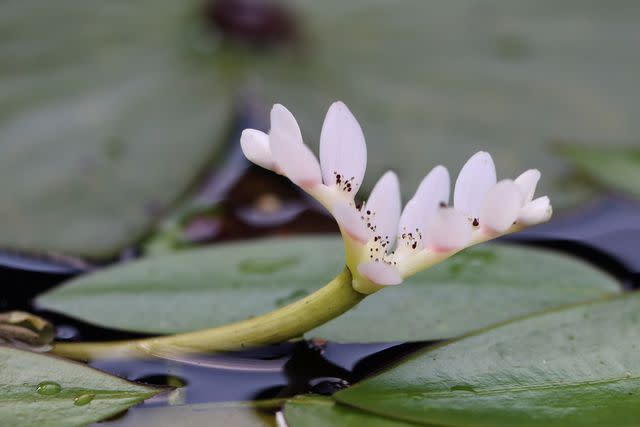
Wicher Bos / Getty Images
Water hawthorn creates unique, V-shaped, multi-petaled flowers with a pleasant vanilla scent in the spring and fall to early winter. It often ceases to bloom during the hot summers. The flowers and long, oval leaves float on the surface of the water, which helps to create shelter for any pond fish or aquatic animals. Water hawthorn prefers cool water temperatures and still, calm water conditions. It grows in water up to two feet deep. It also is a prolific plant and often self-seeds.
Name: Water hawthorn (Aponogeton distachyos)
USDA Hardiness Zones: 6-10
Flower Color Varieties: White
Light: Full sun to partial shade
Soil Needs: Submerged, loamy, acidic to alkaline pH levels
Mature Size: 4 inches above water, 2-3 feet wide
Deer-Resistant: No
Broadleaf Arrowhead

NNehring / Getty Images
Also known as a duck-potato plant, the broadleaf arrowhead produces tubers that are a food source for animals like ducks and muskrats. These plants produce upright, arrowhead-shaped leaves, which is where the name originates from. The plants produce stalks of multiple, small, white flowers with yellow centers. Reaching up to 3 feet above the water, these plants are lovely for adding a vertical element to a waterfall pond or water garden.
Name: Broadleaf arrowhead (Sagittaria latifolia)
USDA Hardiness Zones: 6-9
Flower Color Varieties: White and yellow
Light: Full sun to partial shade
Soil Needs: Soggy or submerged, loamy, mildly acidic to mildly alkaline
Mature Size: 2-3 feet above water, 3-4 feet wide
Deer-Resistant: No
Pickerelweed
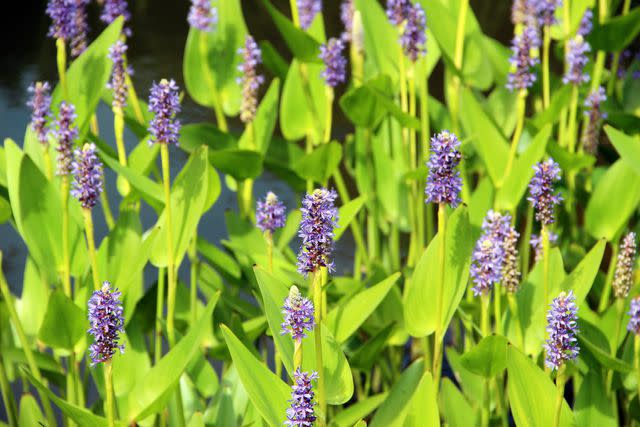
fotolinchen / Getty Images
Pickerelweed grows up to 3 feet tall. These plants sport tall spikes of tiny white, blue, pink, or purple flowers and long, heart-shaped leaves. They are often found naturally where pickerel fish live, which is what earned this plant its name. The plant prefers shallow, calm waters, and is often found growing on the shallow edges of ponds. These plants are a food source for birds and also attract pollinators.
Name: Pickerelweed (Pontederia cordata)
USDA Hardiness Zones: 3-10
Flower Color Varieties: White, blue, purple, pink
Light: Full sun to partial shade
Soil Needs: Soggy or submerged, muddy, loamy, slightly acidic to slightly alkaline
Mature Size: 3 feet above water, 2 feet wide
Deer-Resistant: No
Mosaic Flower
Mosaic flowers add a unique flair to any pond with their small, diamond-shaped leaves that float on the surface, giving the water a mosaic pattern. When grown in full sun, the leaves turn red, adding to this plant’s unique, artistic look. Small, yellow, four-petaled flowers appear in the summer. The dainty flowers cannot tolerate alkaline water conditions, so be sure the water stays at or below neutral. Mosaic flowers spread over the surface of the water, so you will need to occasionally thin the plants out to keep the pond open.
Name: Mosaic flower (Lugwigia sedoides)
USDA Hardiness Zones: 9-11
Flower Color Varieties: Yellow
Light: Full sun to partial shade
Soil Needs: Submerged, heavy loam, slightly acidic to slightly alkaline
Mature Size: 2-3 inches above water, 1-2 feet wide
Deer-Resistant: No
Calla Lily
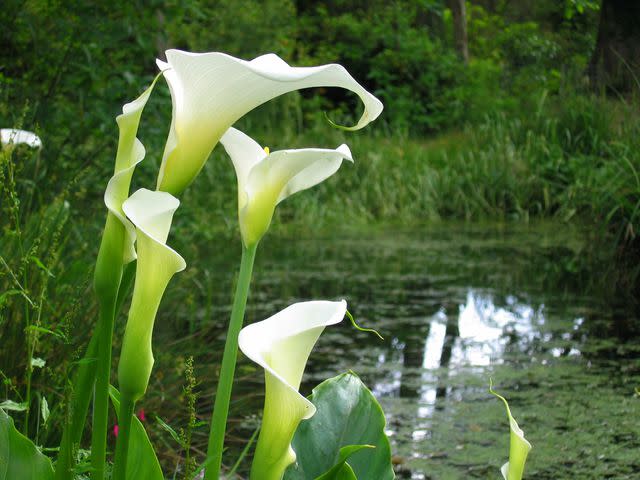
SenexDomum / Getty Images
Because these plants love wet soil, calla lilies make great pond plants. They grow well on the edges of ponds in shallow water. Their wavy foliage and spathe and spadix flowers add movement and interest to any water garden.
Name: Calla lily (Zantedeschia aethiopica)
USDA Hardiness Zones: 8-11
Flower Color Varieties: White
Light: Full sun to partial shade
Soil Needs: Soggy to submerged, loamy, acidic
Mature Size: 2-3 feet above water, 1-2 feet wide
Deer-Resistant: Yes
Swamp Lily
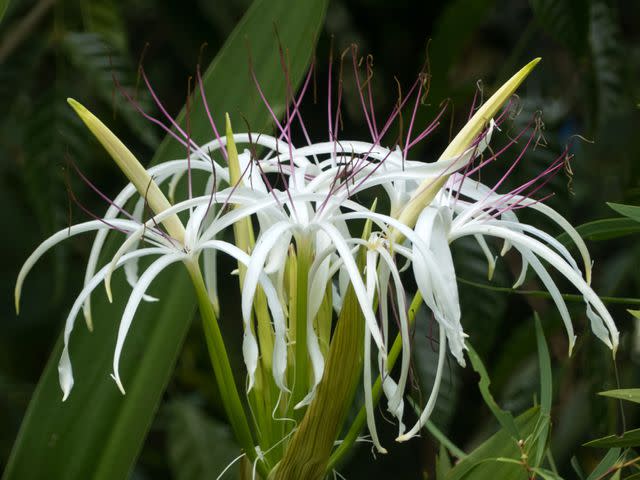
Connie Pinson / Getty Images
Swamp lilies, with their long, narrow petals and long stamens, give an eclectic, wild feel to ponds or water gardens. Aside from their looks, swamp lilies also give off a sweet aroma, making them lovely both to look at and to smell. Swamp lilies reach over 6 feet in height, making them an eye-catching addition to a pond or water garden. These unique flowers grow in wet soil or shallow water.
Name: Swamp lily (Crinum pedunculatum)
USDA Hardiness Zones: 7-11
Flower Color Varieties: White
Light: Full sun to partial shade
Soil Needs: Wet or submerged, loamy, acidic to alkaline
Mature Size: 6-8 feet tall, wide
Deer-Resistant: Yes
Blue Flag Iris
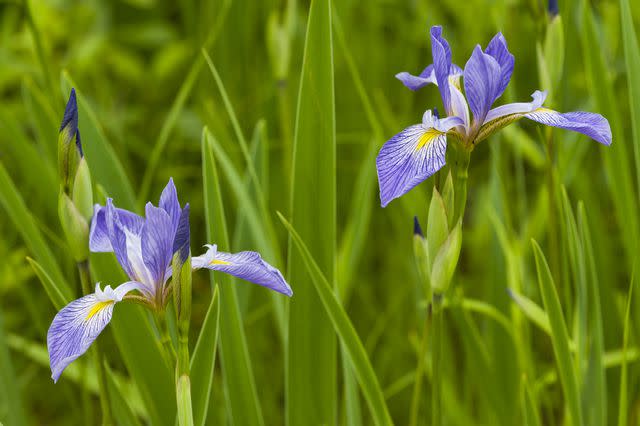
Ed Reschke / Getty Images
Sporting the iconic three-petaled iris blooms, these bright blue flowers add an elegant touch to pond edges. Not only do these flowers look lovely, but planting irises on pond edges helps strengthen the pond borders. Blue flag irises bloom in the early spring to early summer, giving your pond or water garden incredible color early in the year.
Name: Blue flag iris (Iris versicolor)
USDA Hardiness Zones: 2-7
Flower Color Varieties: Blue, purple
Light: Full sun to partial shade
Soil Needs: Wet to submerged, loamy, acidic
Mature Size: 2-3 feet tall, wide
Deer-Resistant: Yes
Cardinal Flower
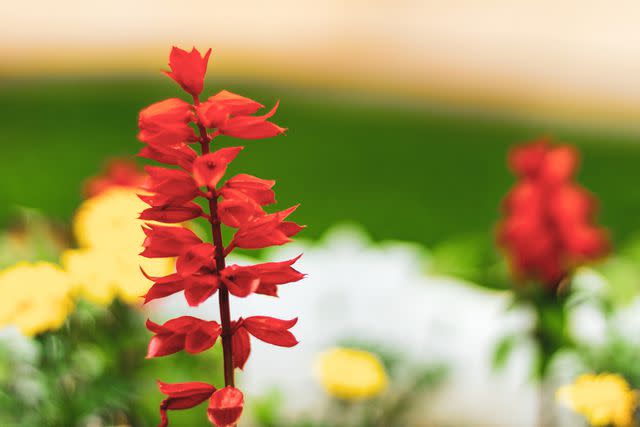
Rafael Abdrakhmanov / Getty Images
Cardinal flower is known for its tall, bright red, trumpet-shaped flowers and its unique petal pattern. These eye-catching flowers are another vibrant plant that is grown in shallow standing water, making them a lovely border plant for ponds. Their bright red color also attracts hummingbirds.
Name: Cardinal flower (Lobelia cardinalis)
USDA Hardiness Zones: 3-9
Flower Color Varieties: Red
Light: Full sun to partial shade
Soil Needs: Wet to submerged, loamy, clay, slightly acidic to slightly alkaline
Mature Size: 3-4 feet above water, 1-2 feet wide
Deer-Resistant: Yes
Marsh Marigold
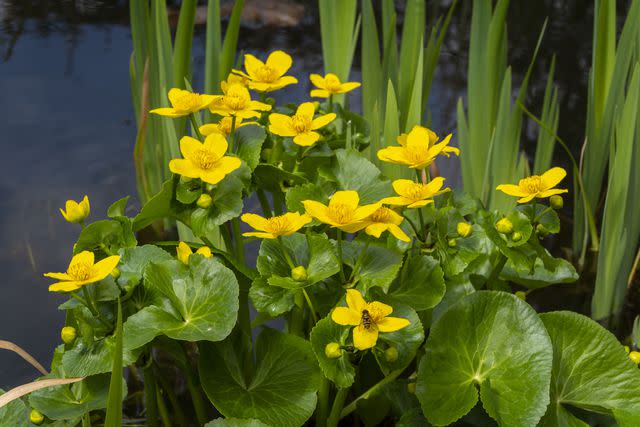
senatorek / Getty Images
Another border plant, marsh marigold is a buttercup-like, yellow flower that blooms in the early spring. While the name suggests that they're part of the Asteraceae family like other marigolds, the reality is that these plants are members of the Ranunculaceae family. These plants have shiny, heart-shaped or kidney-shaped leaves that add to their cheery appearance.
Name: Marsh marigold (Caltha palustris)
USDA Hardiness Zones: 3-7
Flower Color Varieties: Yellow
Light: Full sun to partial shade
Soil Needs: Wet to submerged, loamy, acidic
Mature Size: 1-2 feet tall, wide
Deer-Resistant: Yes
Cattail
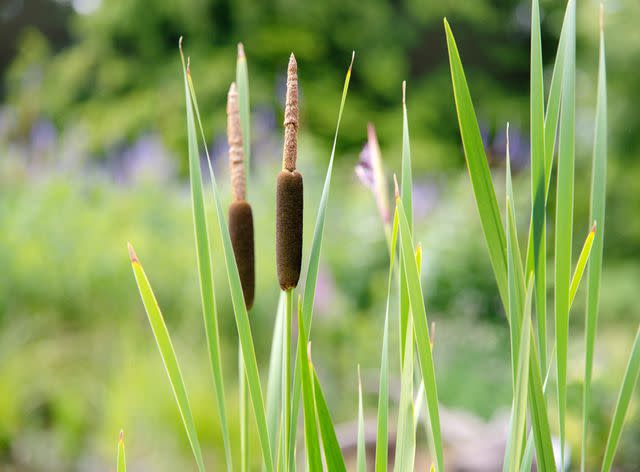
The Spruce / Evgeniya Vlasova
Also known as bulrushes, these perennial aquatic plants grow in shallow waters in boggy marshes and wetland areas. Cattails have an upright growth habit and a tall cylindrical inflorescence. In the right conditions, these fast-growing plants reach up to 10 feet tall. They spread rapidly to form attractive thick clumps that provide cover and nutrition for wildlife. Make sure you select a species such as Typha latifolia, which is native to parts of the United States instead of an introduced species that can become invasive.
Name: Cattail (Typha latifolia)
USDA Hardiness Zones: 3-10
Flower Color Varieties: Brown
Light: Full sun to partial shade
Soil Needs: Moist, wet to marshland or standing water
Mature Size: 5-10 ft. tall, 18-24 in. wide
Deer-Resistant: Yes
Swamp Milkweed
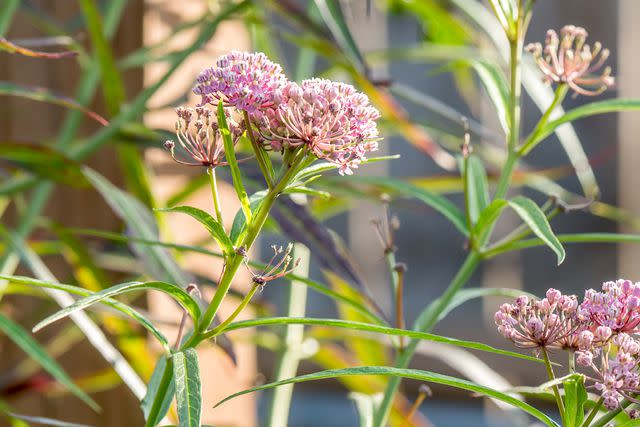
The Spruce / Adrienne Legault
Swamp milkweed, a key host plant for monarch butterflies, thrives along the edges of ponds and streams and in wetlands. Milkweed is slow to emerge from its dormancy in the spring so don't worry if it lags behind other perennials. As the soil warms up, it will send up new shoots. In the summer, swamp milkweed blooms in shades of soft mauve to pink to reddish-violet, sometimes white.
Name: Swamp milkweed (Asclepias incarnata)
USDA Hardiness Zones: 3-6
Flower Color Varieties: Pink, white
Light: Full sun
Soil Needs: Moist, medium to wet clay
Mature Size: 3-5 ft. tall, 2-3 ft. wide
Deer-Resistant: Yes
Frequently Asked Questions
Which water flower is the easiest to grow?
Papyrus, pickerel plant, cardinal flower, water hyacinth, and water lily are all considered easy to grow aquatic plants. Note that vigorously growing plants often spread more than you wish for and border on invasive. That’s why it is usually recommended to grow them in a confined space, such as a floating basket.
Do water flowers need any soil?
It depends on the type of plant. Some aquatic plants are free-floating and absorb nutrients solely through their leaves and do not need any soil while others require soil to survive because their roots draw nutrients from the soil. The soil also acts as an anchor for the plants.
What is the rarest type of water flower?
The pygmy Rwandan water lily (Nymphaea thermarum), a tiny water lily native to only one small location in Rwanda, is one of the rarest aquatic plants in the world.
Read the original article on The Spruce.

